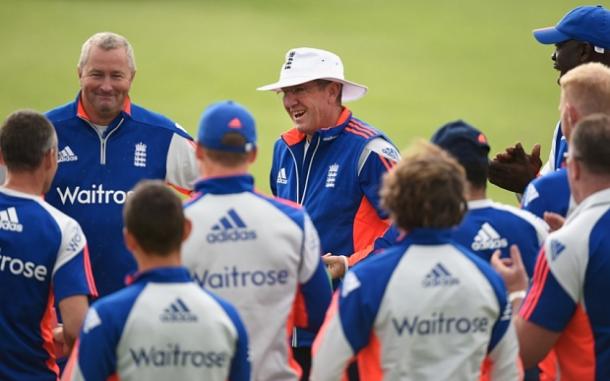England have done it, they've achieved the impossible. They've completed an Ashes series win, dominated almost all opponents in limited overs cricket and even enjoyed a certain level of success in the sub-continent.
Yet, had you suggested this would be the case at the end of 2014, you'd have been the victim of laughter. England had scarcely been in a worse situation. Hammered 5-0 in the Ashes by Australia down under, completely embarrased in the World Cup, even losing to the minnows Bangladesh - and yet somehow they've turned it around.
From the most embarrassing of England sides to one of the most cutting edged. But how? How have they completed such a major turn around? Take a certain ook at it, and you'll deduce three simple steps.
Backroom overhaul
At first the news that almost the entirety of the top-table at the England and Wales Cricket Board was about to change was greeted with a lot of scepticism. People had heard it all before, the idea that this change was going to change English fortunes for ever, it's a story almost as old as cricket itself, and yet for the first time it's worked.
Whilst the lack of movement on their Kevin Pietersen stance was believed by many to show that the ECB really hadn't changed, it in fact proved the complete opposite. By putting a final end to the KP saga, the ECB were sending out a firm message,"we no longer look to the past, but rather the now" and that was crucial in the their new ideas for England.
Even the appointment of Andrew Strauss was critiscised, many stated that appointing a mate of the old generation of the ECB was never going to allow it to progress, yet the appointment was a masterstroke. Rather than being appointed as a mate, he was appointed as a cricket man.
Strauss was relatively recently retired from international cricket and so he understood the challenges Alastair Cook and his men were up against. But more importantly than anything, he valued limited overs cricket. He recognised that if England could sort out their limited overs cricket everything else would fall into place around it. But to do this he knew he needed more than an overhaul of the ECB he needed an entire overhaul of England's backroom staff, and overhauled it was.

Peter Moores was shown the door following the World Cup (and a downright boring West Indies tour) as it was announced that Trevor Bayliss would take over in time for the Ashes, with Paul Farbrace filling in between. While many will credit Bayliss for England's change in fortunes, Paul Frabrace's role should be duly noted. It was the Englishman who was in control for the New Zealand series in which this new look England side caught the eye of cricket fans across the globe, this new England side was clearly now a force to be reckoned with, Farbrace actually gave England a great deal of confidence ahead of the Ashes series.
Peter Moores had been appointed due to his high amounts of previous success in the longer forms of the game, yet he had never shown an exceptional prowess in limited overs side. Whereas Trevor Bayliss on the other hand was appointed almost purely on his limited overs success. The Australian had won the Indian Premier League twice with the Kolkata Knight Riders and the Big Bash League once with the Sydney Sixers, winning the Champions League T20 in the same year. Bayliss had arrived and so had this new era of English cricket.

New talents
England had always been faced with one glaring problem. They always were reluctant to change. Therefore when the squad to face New Zealand was announced, and it included seven new players, the media and cricket world alike were shocked.
Cast aside were their old, now failing, guard, as England went back to the Counties and took their pick from a much wider pool. Cricket in England has always had one major issue. It is seen as elitist. It's the exact reason that when players such as Freddie Flintoff come along they're immediately taken into the publics hearts. This was the masterstroke pulled with the selectors with players like Ben Stokes.
Stokes, Mark Wood and even Joe Root all come across as good lads who have come through working families and somehow infiltrated this so called "elitist" sport. You just have to listen to the new team talk, they're laughing, joking and just generally enjoying their time in an England shirt. All three squads all of a sudden became squads of the people, the squads featured players people could relate to, but also seemed to take notice of the public's selection suggestions.
It wasn't just their character thought that made this new breed so exciting, the players actually performed, the beforehand fringe players were now taking their chances by the scruff of the neck, determined to change this one-off chance into a regular spot.
For evidence of this you have to look no futher than James Vince, the attacking batsman had been the centre of most people's recommendations for the new squads, yet because of the rest of the team playing so well he was made to wait. He didn't get his chance until what was almost the year's final series. Brought into the T20 side for the series against Pakistan, the Hampshire batsman was thrust straight into batting at number three and rather than being overawed by his sudden inclusion, he infact finished as the highest England run-scorer in the series.
It's these kinds of performances that are giving the England selectors a welcome head-ache ahead of the World T20 in March.

Of course no piece regarding England's revival could be complete without a mention of Joe Root. What a talent this young batsman has become this year. The Yorkshireman was dropped for the last Test of the fateful Ashes series down under, and by his own admission he used it as motivation for this year, hating missing time out of playing for England, the batsman adressed the major issues with his technique, but also managed to keep his seemingly effortless ability to score runs and at a good rate aswell.
After being dropped, the batsman has returned with a record breaking year. Root has scored 2,131 runs for England this year, nearly 800 runs more than Cook who scored the second most runs for England, more amazingly however Joe Root broke the record for the most runs scored in a calendar year for England ever. Root's 2,131 runs finally toppled Pietersen's record of 2,120 runs set over eight years ago.
Adding to all that, he climbed the rankings to be number one in the world, in regard to test match batting.

A new way to play
A major catalyst however has been the revolution in playing style. Far removed from the negative style that was such a staple of previous England side, this new era has been extremely gung-ho in their approach, capturing the publics attention, and playing with a new found freedom.
Having escaped the opressive reign of Peter Moores, England's stars are now being allowed to express themselves and show what they're trult capable of. The side has gone from just avoiding defeat to now chasing victories, a statement proved by England's One Day International series against New Zealand. The series broke almost every record it could break, including England's record score when they posted 408 from 50 overs in the First ODI.

While the coaches can of course take some due credit, it is infact the players who have made the change possible. Batsmen such as Jos Buttler and Eoin Morgan have played explosive innings while a new look bowling attack featuring the likes of Reece Topley and Chris Woakes have backed up the batsmen's efforts. Yet the entire team have come together to make the new message very clear.
England are back and they're better than ever.








































